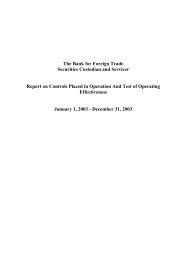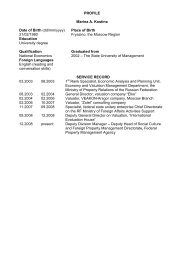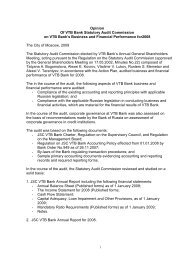Annual report 2011 - VTB
Annual report 2011 - VTB
Annual report 2011 - VTB
- No tags were found...
Create successful ePaper yourself
Turn your PDF publications into a flip-book with our unique Google optimized e-Paper software.
<strong>VTB</strong> BankNotes to the Consolidated Financial Statements – 31 December <strong>2011</strong> and 2010(in billions of Russian Roubles)38. Financial Risk Management (continued)Credit quality by class of loans and advances to customers (continued)For the purposes of the above table, the amount of past due loans and advances includes the entire outstandingamount of the loans, out of which the current portion amounts to RUR 0.5 billion and overdue portion amounts toRUR 61.9 billion at 31 December <strong>2011</strong> (31 December 2010: RUR 37.0 billion and RUR 54.5 billion correspondingly).Collateral and other credit enhancementsExposure to credit risk is managed, in part, by obtaining collateral and guarantees issued by state authorities, entitiesand individuals.The amount and type of collateral accepted by the Group depends on credit risk assessment of the counterparty.Guidelines are implemented regarding the acceptability of types of collateral and valuation parameters.Collateral received by the Group from borrowers as a result of loan settlement is usually represented by real estate,inventory and trade receivables.Securities and guarantees are also obtained from counterparties for all types of lending.The list of acceptable forms of credit support is subject to periodical review. Different forms of credit support may beused in combination. In cases when a loan is secured by guarantees received, the Group performs an analysis of theguarantor’s financial performance, except for the state authorities.The Group has a set of requirements applicable to each form of credit support. The value of the pledged property isdetermined by reference to its market value taking into account a liquidity margin. The value of the assets determinedfor these purposes must be sufficient to recover principal, interest, commissions and expenses related to theenforcement of the pledge. A liquidity margin related to different types of pledges varies from 15% to 70%.The valuation and acceptance of each type and item of collateral may vary depending on individual circumstances.Generally, the Group takes collateral with a view to ensure that an adequate margin is obtained and maintainedthroughout the term of the facility, where applicable. The appropriate department responsible for collateralassessment establishes parameters for each individual facility.In cases where a loan is secured by a pledge, the borrower is required to insure such assets and name the Group asthe beneficiary of the insurance policy. The Group takes a complex approach to pledged assets insured. It dependson the level of risk involved in the loan operation, the borrower's financial condition and the risk of loss of the pledgedproperty.Collateral is taken to enhance an acceptable credit proposal, rather than being used as the sole rationale for anycredit approval. Where facilities are approved against security, full details, including the type, value, and thefrequency of review of the security should be detailed in the Application for Credit Facility Form. Where practical, anbank officer conducts inspection the physical existence of collateral offered.The Group reassesses the fair value of pledged property with frequency stated for each form of pledge and, ifnecessary, requires additional collateral or other acceptable forms of credit support.The financial effect of collateral is presented below by disclosing the gross carrying value of the customer loanportfolio values separately for (i) those loans where collateral and other credit enhancements are equal to or exceedcarrying value of the loan ("over-collateralized ") and (ii) those loans where collateral and other credit enhancementsare less than the carrying value of the loan or where credit support obtained is not considered by the Group as asufficient for credit risk mitigation ("under-collateralized ").The Group treated “over–collateralized” loans as loans for which a credit risk is minimized nearly in full as at the<strong>report</strong>ing date. As to “under-collateralized” loans the Group estimates a percentage of credit risk mitigated byobtaining a credit support in range from 0% to 75% of carrying value of the loan.71
















